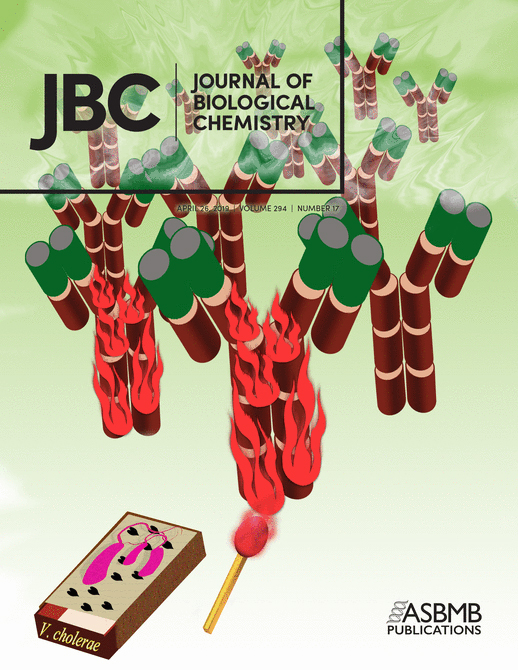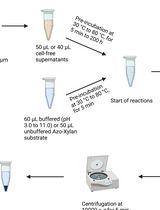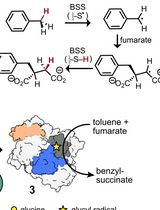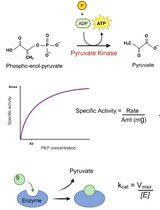- EN - English
- CN - 中文
An in vitro Assay to Screen for Substrates of PKA Using Phospho-motif-specific Antibodies
利用磷酸基团特异性抗体体外筛选PKA底物
发布: 2020年04月20日第10卷第8期 DOI: 10.21769/BioProtoc.3587 浏览次数: 3913
评审: Gal HaimovichNathalie EisenhardtAnonymous reviewer(s)
Abstract
Kinases function as regulators of many cellular processes such as cell migration. These enzymes typically phosphorylate target motif sequences. Mass spec or phospho-specific antibody detection can be used to determine whether a kinase can phosphorylate proteins of interest, however, mass spec can be expensive and phospho-antibodies for the protein of interest may not exist. In this protocol, we will describe an in vitro kinase assay to provide a preliminary readout on whether a protein of interest may be phosphorylated by PKA. Our protein of interest is purified after expression in bacteria and treated with recombinant PKA from bovine heart. Protein is then extracted and a western blot is performed using a phospho-specific antibody for PKA’s target motif. This will allow us to quickly determine if it is possible for PKA to phosphorylate our protein of interest.
Keywords: Protein Kinase A (PKA) (蛋白激酶A)Background
Hormones and other factors that cause activation of adenylate cyclase through G-linked G-protein coupled receptors (GPCR) and subsequently promote generation of second messenger cAMP can affect cellular processes like cell migration. Elevation of cAMP level leads to activation of PKA, a serine-threonine kinase that plays an important role in the regulation of actin cytoskeletal dynamics in migrating cells. PKA influences different facets of actin cytoskeleton-regulatory processes including modulation activities of a) Rho-family GTPases (Rho, Rac and Cdc42), b) actin-binding proteins (e.g., VASP [vasodilator stimulated phosphoprotein]), c) kinases which indirectly control the function of actin-binding proteins (e.g., p21-activated kinase) and d) myosin (Howe, 2004). PKA and other kinases, however, can also modulate other proteins by phosphorylation that are currently unknown.
There are multiple ways to determine kinase activity on a protein of interest such as mass spec for phosphopeptides, however, such assays can be costly. In this protocol, we will describe the use of an in vitro kinase assay to examine PKA kinase activity on a GST-tagged protein of interest using a phospho-specific antibody for PKA’s target motif. Using a PKA motif antibody is advantageous if known phosphorylation sites are unknown on a protein or if no phosphospecific protein antibody exists. While this assay is quick and simple to perform, it depends on the kinase targeting a motif pre-determined by available antibodies and thus limited in potential. A different kinase can be easily tested if an antibody to detect that kinase’s phospho motif exists. Despite this, successful readout from this assay can provide motivation to pursue more comprehensive exploration into kinase phosphorylation of a protein of interest. Although this protocol describes usage of recombinant protein purified from bacteria, protein can be obtained from any source (i.e., insect or human cells) but total yield of protein will vary dependent on the source and may need to be optimized. Figure 1 below illustrate the general workflow for this protocol.

Figure 1. General protocol workflow for kinase analysis
Materials and Reagents
- Eppendorf tubes
- Bacteria culture tube (Southern Labware, catalog number: 110178 )
- BL21 competent E. coli (New England BioLabs, catalog number: C2530H )
- LB Broth (Thermo Fisher, catalog number: 10855001 )
- LB Agar Ampicillin-100 (Sigma-Aldrich, catalog number: L5667 )
- IPTG (Sigma-Aldrich, catalog number: I6758 )
- Ampicillin 100 mg/ml (Sigma-Aldrich, catalog number: A5354 )
- Glutathione Agarose (Thermo Fisher, Pierce, catalog number: 16100 )
- Protease inhibitor cocktail for bacteria (Sigma-Aldrich, catalog number: P8465 )
- pGEX-4T1 GST-fusion vector (Sigma-Aldrich, catalog number: GE28-9545-49 )
- PBS (Lonza, BioWhittaker, catalog number: BW17516F )
- IP Lysis Buffer (Thermo Fisher, Pierce, catalog number: 87787 )
- PKA (Sigma-Aldrich, catalog number: P2645-400UN )
- Laemmli SDS sample buffer, reducing 6x (Alfa Aesar, catalog number: J61337-AC )
- BES (Thermo Fisher, BioReagents, catalog number: BP501500 )
- EGTA (Tocris Bioscience, catalog number: 28-071-G )
- MgCl2 (Thermo Fisher, catalog number: AB0359 )
- ATP (Sigma-Aldrich, catalog number: A7699 )
- Phosphocreatine (Sigma-Aldrich, catalog number: P7936 )
- DTT (Sigma-Aldrich, catalog number: D9779 )
- Prestained protein ladder (Thermo Fisher, catalog number: 26616 )
- 15% Criterion Tris-HCl protein gel (Bio-Rad, catalog number: 3450019 )
- 10x Tris/Tricine/SDS running buffer (Bio-Rad, catalog number: 1610744 )
- 10x Tris/Glycine transfer buffer (Bio-Rad, catalog number: 1610734 )
- Methanol (Thermo Fisher, Fisher Chemical, catalog number: A412-500 )
- Nitrocellulose membrane (Bio-Rad, catalog number: 1620115 )
- TBS-T (Bio-Rad, catalog number: BUF028 )
- BSA (Thermo Fisher, BioReagents, catalog number: BP1600100 )
- Phospho-PKA subtract RRXS antibody (Cell Signaling Technology, catalog number: 9624 )
- Peroxidase Goat Anti-Rabbit IgG (Jackson ImmunoResarch, catalog number: 111-035-144 )
- Clarity ECL (Bio-Rad, catalog number: 1705060 )
- Kinase buffer (see Recipes)
- IPTG solution (see Recipes)
Equipment
- Refrigerated Centrifuge for Eppendorf tubes (Sorvall, Legend RT, SO-LEGRT)
- Eppendorf tube heater (Lab Line, Multi Blok Heater, LV40429530)
- Shaking incubator set to 37 °C (Thermo Scientific, MaxQ 5000, SHKE50007)
- Waterbath or drybath set to 37 °C (Boekel Scientific, Small Water Bath, 290100)
- Sonicator (Bransonic, Ultrasonic Baths, CPX-952-116R)
- Rotator for Eppendorf tube (Boekel Scientific, Scientific Rotating Tube Rotator, UX-51202-00)
- Microcentrifuge (Thermo Scientific, accuSpin Micro 17, 13-100-676)
- Mini Trans-Blot (Bio-Rad)
- Mini-PROTEAN Tetra cell (Bio-Rad)
- ChemiDoc XRS+ System (Bio-Rad)
Software
- ImageLab (Bio-Rad)
Procedure
文章信息
版权信息
© 2020 The Authors; exclusive licensee Bio-protocol LLC.
如何引用
Readers should cite both the Bio-protocol article and the original research article where this protocol was used:
- Gau, D. M. and Roy, P. (2020). An in vitro Assay to Screen for Substrates of PKA Using Phospho-motif-specific Antibodies . Bio-protocol 10(8): e3587. DOI: 10.21769/BioProtoc.3587.
- Gau, D., Veon, W., Shroff, S. G. and Roy, P. (2019). The VASP-profilin1 (Pfn1) interaction is critical for efficient cell migration and is regulated by cell-substrate adhesion in a PKA-dependent manner. J Biol Chem 294(17): 6972-6985.
分类
分子生物学 > 蛋白质 > 磷酸化
细胞生物学 > 基于细胞的分析方法 > 酶学测定
生物化学 > 蛋白质 > 活性
您对这篇实验方法有问题吗?
在此处发布您的问题,我们将邀请本文作者来回答。同时,我们会将您的问题发布到Bio-protocol Exchange,以便寻求社区成员的帮助。
提问指南
+ 问题描述
写下详细的问题描述,包括所有有助于他人回答您问题的信息(例如实验过程、条件和相关图像等)。
Share
Bluesky
X
Copy link













